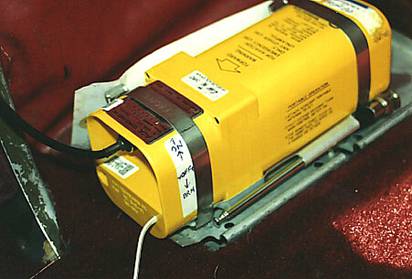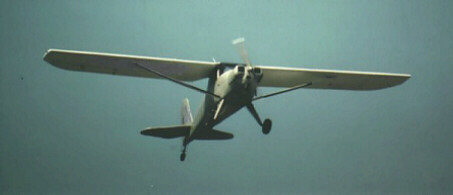Let's Take the SAR... out of "garbage"!

Have you removed the batteries?
"What's that?" you say " There's no SAR in garbage, regardless of what language you're spelling." That may be true. But a month or so ago, there were numerous SAR techs and other SAR-related people rummaging around in a Canadian garbage dump, much to the consternation of the resident Jonathan Live-it-up seagulls, who are not accustomed to fighting with SAR techs for their share of the — ahem — spoils.
What on earth brought them there? Initially, it was something above the earth. COSPAS-SARSAT to be exact. These alert sentries detected an ELT signal. Using suitable linkage, the SAR system came up with a fairly large circle in which the ELT could be located. A SAR aircraft initially aimed at the circle, then, as it flew closer to the site, homed to the beacon. The spotters squinted through their various windows, looking for the scattered remains of an aircraft.
Despite their squintiest gazes, there was no sign of an aircraft, but there was lots of aerial activity. Flocks of seagulls, buzzards and pterodactyls wheeled soared and swung in the air currents wafting heavenward from the local garbage dump.
Could the aircraft have gone in like a dart and have been covered up with garbage? Perhaps, but there were no reports of missing aircraft in the local area. Besides, as garbage dumps go, this one was reasonable tidy. It did not look as though it had recently been re-arranged to accommodate a crashed aircraft.
But there was no doubt about it. The ELT signal was coming from the garbage dump. What to do? Find it. Thus it was that a flock of folks went rummaging through a garbage dump looking for a transmitting ELT.
Eventually, they found it. Down at about the 3-ft level, searchers came upon a perfectly serviceable ELT, squawking its little electronic heart out. Someone had discarded it with the batteries still inside, and the function switch in the ON position. When the bulldozer operator came along to spread out fresh treats for the gulls, the blade evidently gave the ELT a sharp enough rap to set it singing.
SAR was in the seagull-herding business on the West Coast, as well. Several aircraft, Vancouver Area Control Centre and the satellites all reported an ELT close to Vancouver Harbour. Again, there were no reports of missing aircraft, and the ATS people running the harbour traffic still had an equal number of takeoffs and landings. Even if they hadn't, any ELT that had slipped below the waters wouldn't be disturbing all those folks on the surface. A SAR Labrador was summoned. Again, the spotters had their eyeballs spring-loaded to the pop-out position. When they got close to the "on-top" position they looked down a saw a ship. The signal ceased before they could confirm its origin. They went home.
A few hours later, the Coast Guard reported hearing an intermittent ELT signal. Industry Canada was called in. After following the bouncing signal around the Harbour, they were led to the same ship which had attracted the Lab. Being a container ship, it was full of, what else?, containers. Inside one of the containers was a neatly packaged helicopter headed to an exotic foreign destination.
Inside the helicopter was — you guessed it — an ELT with its function switch in the ARMED position. Apparently the crane operator didn't set the helicopter container on the deck with the same delicacy that a pilot might have used. The ELT thought that it had crashed. Despite all the bits of ship that were in the way, the signal still made it out into the ether with sufficient strength to keep SAR excited for the best part of eight hours.
Not many people are discarding ELTs right now. The ones that they have are adequate; they'll do until the regulations change, some time around the year 2000. But as that time comes closer, more people will buy new ELTs and discard their old ELTs. If they do it the way that the garbage dumper did it, they could destroy the SAR alerting system for a lengthy period.
Never, ever, throw away an ELT with a battery in it. Never, ever, throw away an ELT with its function switch ARMED or ON; battery or no battery. The transmission from an undamaged ELT in a garbage dump can mask a transmission from a damaged ELT trying to alert SAR to an emergency.
Similarly, if you're shipping an aircraft by ship, train, truck or air, ensure that the ELT function switch is OFF. If possible, remove the batteries. Placard the aircraft when you do this, so that the pilot at the other end of the voyage knows that the ELT — and the batteries — must be re-installed before flight.
The ELT-SARSAT-SAR-CASARA team works well to provide SAR alerting, pinpointing and rescue. Around the world, the team has been instrumental in locating and rescuing 1624 aviators in 755 aviation distresses since 1982.
Good as they are, they need your help. You buy, use, maintain and eventually discard the alerting part of the system. When doing so, please use the same high standards of airmanship that mark your other aviation activities.
Help keep SAR out of garbage dumps. It'll help prevent neurotic seagulls.
Originally Published: ASL 4/1997
Original Article: Let's Take the SAR...out of "garbage"!
Twice Lost, Twice "Fuelish", Twice Saved by Alert Flight Service Specialists

Luscombe in flight.
The solo Luscombe SL-8 pilot was en route VFR from Fort Nelson, British Columbia, to Watson Lake, Yukon Territory. Its barely more than 100 NM as the crow flies, and slightly longer if youre flying IFR ("I Follow the Road"). When the pilot became uncertain of his position (read "lost"), he called the Whitehorse FSS through the Watson Lake remote communications outlet. The alert specialist who took the call advised the pilot to climb and attempt to locate the highway.
Following the advice, the pilot located his position over the highway; unfortunately, at about the same time, he ran out of gas. The engine quit, and he made a successful forced landing on the Alaska Highway. Co-operative RCMP officers arranged for fuel and blocked the highway, allowing the intrepid pilot to depart again to continue to Whitehorse.
Several days later, it was the same aircraft, the same pilot and the same story. This time, the Luscombe pilot was flying from Atlin, British Columbia, to Juneau, Alaska another 100 NM trip if you take the direct route, but longer if youre flying IFR (here, this means "I Follow the River").
This time, the Whitehorse flight service specialist overheard a United Parcel Service courier flight attempting to assist the Luscombe pilot, who, having flown past his intended destination, was lost somewhere south of Juneau and had only 30 min. of fuel remaining.
The specialist suggested that the pilot activate his ELT. Then he alerted the Victoria Rescue Coordination Centre, the Juneau FSS and the United States Coast Guard to the serious situation. With the aid of the ELT, the Coast Guard helicopter quickly located the crash site and the pilot, who was waving from the shoreline.
Fly IFR in the northern mountains (thats "I Follow Roads/Rivers"), have good maps, be meticulous in your map reading (a GPS wouldnt hurt), carry full fuel and, above all, listen to and bless those flight service specialists.
Originally Published: ASL 3/1997
Original Article: Twice Lost, Twice "Fuelish", Twice Saved by Alert Flight Service Specialists
Landed OK... But Couldn't Call for Help!
Recently, a Cessna pilot in the Yukon Territory did a great job of landing his aircraft in a swamp after the engine oil vacated the premises. Neither the pilot nor the aircraft was damaged during the few moments of stark terror that punctuated his many hours of routine flying.
Just before the landing, the pilot transmitted a "Mayday" that was overheard by two overflying aircrafts and relayed to a nearby FSS. However, the position transmitted was more generic than it was exact. The FSS notified the rescue coordination centre (RCC). A major search began promptly, employing about six aircrafts. The searchers found nothing the first day.
The next morning, an RCMP aircraft aiding in the search found the undamaged aircraft sitting forlornly in its swamp. A search and rescue (SAR) aircraft sped to the scene and lifted out the uninjured pilot. So what's the problem?
A couple of things might have sped the rescue and reduce search costs. According to a report filed by the RCC after the event, "The pilot was unaware of effort put into search. Also had no clue that ELT could be picked up by satellite, his radios could be heard by overflights, or that numerous grizzly bears were in the area."
The pilot was not unique in not knowing how to attract SAR's attention to an emergency site. Other survivors have also awaited ... and awaited... and awaited rescue while neglecting to flash up the ELTs or radios to summon help quickly.
Rather than concentrate on the things that could have been done better, let's focus first on what went right. The "Mayday" call alerted two aircraft, the FSS and the RCC. The position was a bit vague but, in northern Canada, that's to be expected. Then there was the landing, which was apparently a superb piece of airmanship.
Could more have been done? As it turned out, yes. The aircraft contained an automatic fixed ELT and a portable ELT. The arrival did not excite the fixed ELT, and the pilot didn't think to turn on the portable. Thus, search aircraft had nothing to home to. After the landing, the pilot did not attempt to use the aircraft radios to contact high flyers. Oddly enough, not using the radios may have been the prudent course of action. A forced landing may have resulted in an unnoticed fuel leak. Flashing up the aircraft electrics could have resulted in a spark-a spark sufficient to ignite the spilled fuel. Although the resulting fireball and smoke plume might have attracted search aircraft, it's not a recommended technique.
Now let's sort out a few ground rules to help SAR pluck you from the site of your emergency landing. If, someday, you find yourself in the same situation as this pilot, down and undamaged but immobile-place the ELT function switch to the ON position. Leave it on. Within 90 min, COSPAS-SARSAT will hear it. Within three hours, SAR will have a fix. Someone will come to get you. As well, most military aircraft monitor 121.5 MHz, and if they or other high flyers in the area report your ELT, SAR might get there even sooner.
Are you using the aircraft radios to talk to local high flyers? If your forced landing was relatively jolt-free, there is no obvious damage, and you can't smell avgas, it's probably OK. But remember, avgas is distilled to be susceptible to small sparks. Turning on electrics may trigger a fireball that will alert SAR agencies three provinces away.
ELTs were intended to attract SAR to emergencies. A forced landing in a swamp with an oil free aircraft constitutes an emergency. In this case, the company had two ELTs aboard the aircraft. Either one could have been used to summon help to an aircraft and pilot that were going no farther that day. Fewer search aircraft would have been needed and the pilot would have spent less time contemplating nature. Fortunately, he did not have to contemplate the grizzly bears that are a formidable part of that area of nature.
And, contrary to popular opinion, grizzly bears don't have 121.5 MHz ears, so turning on the ELT won't attract them. It will attract the SAR aircraft that will prevent you from having to outrun them.
Originally Published: ASL 2/1997
Original Article: Landed OK...But Couldn't Call for Help!




























